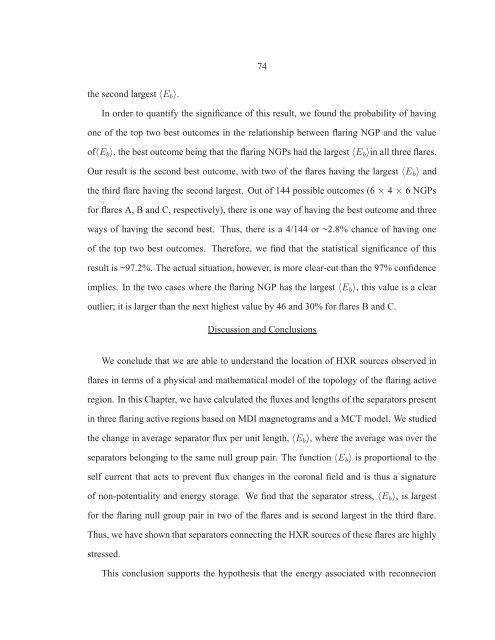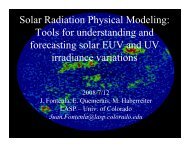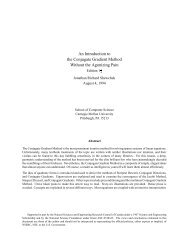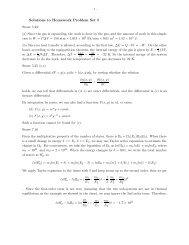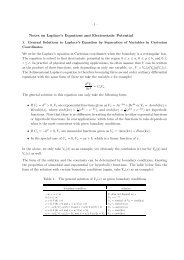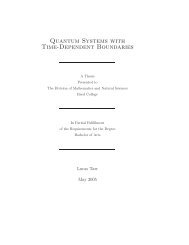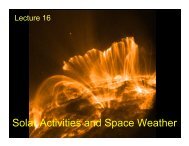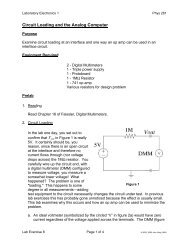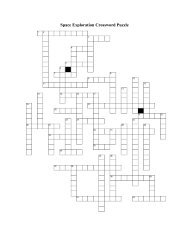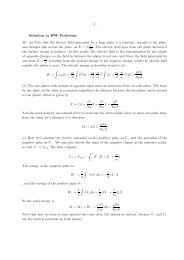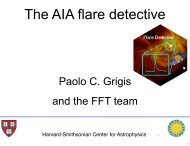The Topology of Magnetic Reconnection in Solar Flares
The Topology of Magnetic Reconnection in Solar Flares
The Topology of Magnetic Reconnection in Solar Flares
You also want an ePaper? Increase the reach of your titles
YUMPU automatically turns print PDFs into web optimized ePapers that Google loves.
74the second largest 〈E b 〉.In order to quantify the significance <strong>of</strong> this result, we found the probability <strong>of</strong> hav<strong>in</strong>gone <strong>of</strong> the top two best outcomes <strong>in</strong> the relationship between flar<strong>in</strong>g NGP and the value<strong>of</strong>〈E b 〉, the best outcome be<strong>in</strong>g that the flar<strong>in</strong>g NGPs had the largest 〈E b 〉<strong>in</strong> all three flares.Our result is the second best outcome, with two <strong>of</strong> the flares hav<strong>in</strong>g the largest 〈E b 〉 andthe third flare hav<strong>in</strong>g the second largest. Out <strong>of</strong> 144 possible outcomes (6 × 4 × 6 NGPsfor flares A, B and C, respectively), there is one way <strong>of</strong> hav<strong>in</strong>g the best outcome and threeways <strong>of</strong> hav<strong>in</strong>g the second best. Thus, there is a 4/144 or ~2.8% chance <strong>of</strong> hav<strong>in</strong>g one<strong>of</strong> the top two best outcomes. <strong>The</strong>refore, we f<strong>in</strong>d that the statistical significance <strong>of</strong> thisresult is ~97.2%. <strong>The</strong> actual situation, however, is more clear-cut than the 97% confidenceimplies. In the two cases where the flar<strong>in</strong>g NGP has the largest 〈E b 〉, this value is a clearoutlier; it is larger than the next highest value by 46 and 30% for flares B and C.Discussion and ConclusionsWe conclude that we are able to understand the location <strong>of</strong> HXR sources observed <strong>in</strong>flares <strong>in</strong> terms <strong>of</strong> a physical and mathematical model <strong>of</strong> the topology <strong>of</strong> the flar<strong>in</strong>g activeregion. In this Chapter, we have calculated the fluxes and lengths <strong>of</strong> the separators present<strong>in</strong> three flar<strong>in</strong>g active regions based on MDI magnetograms and a MCT model. We studiedthe change <strong>in</strong> average separator flux per unit length, 〈E b 〉, where the average was over theseparators belong<strong>in</strong>g to the same null group pair. <strong>The</strong> function 〈E b 〉 is proportional to theself current that acts to prevent flux changes <strong>in</strong> the coronal field and is thus a signature<strong>of</strong> non-potentiality and energy storage. We f<strong>in</strong>d that the separator stress, 〈E b 〉, is largestfor the flar<strong>in</strong>g null group pair <strong>in</strong> two <strong>of</strong> the flares and is second largest <strong>in</strong> the third flare.Thus, we have shown that separators connect<strong>in</strong>g the HXR sources <strong>of</strong> these flares are highlystressed.This conclusion supports the hypothesis that the energy associated with reconnecion


